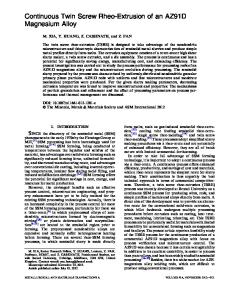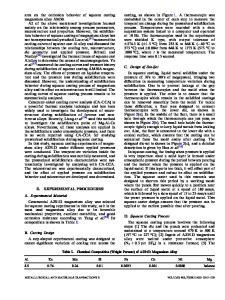Qualitative model for creep of AZ91D magnesium alloy
- PDF / 1,651,592 Bytes
- 11 Pages / 612 x 792 pts (letter) Page_size
- 90 Downloads / 300 Views
INTRODUCTION
THE current article deals with the characterization and modeling of the creep process of a cast AZ91D magnesium alloy ingot (9 wt pct Al, 1 wt pct Zn). The work is part of a broader investigation of the influence of the microstructure on the creep properties of the alloy. Another part of this research has already been published elsewhere by the authors.[1,2] Very little is known about the high-temperature properties of this alloy, especially concerning its creep behavior. Only a few creep studies were conducted with the AZ91D magnesium alloy,[3–18] all in the die-cast condition. These studies presented creep data for engineering usage but made no advanced metallurgical investigation or any correlation with models. More intensive research work was done on pure magnesium[19–28] and on magnesium that contained 0.8 pct aluminum in solid solution.[29] Correlation with models for AZ91D appears only in the works of Blum et al.[30,31] and Watzinger et al.[32] The creep mechanisms suggested in the works mentioned are discussed in the remainder of this section. Vagarali and Langdon[21] performed creep tests on polycrystalline magnesium over the temperature range 200 ⬚C to 547 ⬚C. According to these authors, extensive basal slip takes place in the lower part of the temperature range (up to ⬃327 ⬚C through 477 ⬚C) and creep is controlled by dislocation climb. The activation energy for creep is independent of stress and is ⬃135 ⫾ 10 kJ/mole, which is in agreement with the value for lattice self-diffusion. The stress exponent is close to ⬃5.2 but increases to ⬃6.5 around 200 ⬚C. Power law breakdown is observed at stresses above /G ⬵ 1.3 * 10⫺3. In the temperature range above ⬃327 ⬚C through 477 ⬚C and under stresses above ⬃2.5 MPa, the stress exponent is ⬃6 and the activation energy Q (in kJ/ mole) is stress () dependent: Q ⫽ (140 ⫾ 10) ⫹ (295/)
[1]
M. REGEV, Senior Researcher, is with the Institute of Metals, Technion City, Haifa, Israel. A. ROSEN and M. BAMBERGER, Professors, are with the Department of Materials Engineering Technion-Israel Institute of Technology, Technion City, Haifa, Israel. Manuscript submitted July 11, 2000. METALLURGICAL AND MATERIALS TRANSACTIONS A
where Q is the activation energy (kJ/mole) and is the stress in MPa. The controlling process in this range is the cross-slip of dislocations to nonbasal planes. In the higher temperature range and at stresses below 2.5 MPa, the activation energy is constant, ⬃139 kJ/mole, and the stress exponent is ⬃1. The creep mechanism under these conditions is the Nabarro– Herring diffusion creep. Milic˘ka et al.[19] investigated creep of pure magnesium in the temperature and stress ranges 127 ⬚C through 527 ⬚C and 10 through 100 MPa, respectively. They divided the stress interval into two regions: high stress (above ⬃40 MPa) and low stress (below ⬃30 MPa) with a transition at a region in between. In the high-stress region, the stress exponent decreases with increasing temperature from ⬃10 at 127 ⬚C to ⬃7.5 at ⬃287 ⬚C, the apparent activation energy de
Data Loading...











